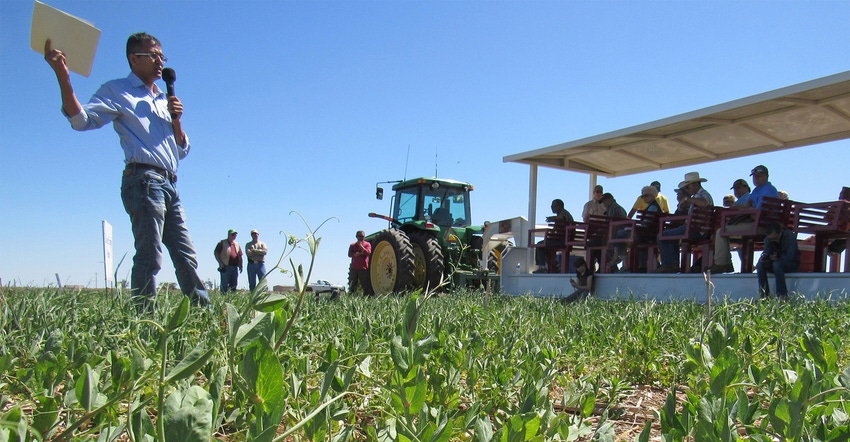May 30, 2019

In an area of New Mexico where a history of high crop production is being threatened by a declining source of water, College of Agricultural, Consumer and Environmental Sciences researchers are using innovation and know-how to move from concern to confidence in the economic viability of agriculture in the region.
Dr. Sangu Angadi, an NMSU crop scientist, after being engulfed in the dust of a prairie windstorm and learning of fatalities that followed due to low visibility from the same storm in West Texas, is seeking solutions to increase water efficiency and hopefully reduce fallow fields, which are often the culprit of such storms.

New Mexico, stretches from the center of a field toward the horizon. Dwindling water availability in recent years had caused many farmers to irrigate only two-thirds of their circular fields, with a third left fallow. To NMSU researchers, those fallow areas seemed like an ideal opportunity for the “buffer strips” project.
INNOVATION
Angadi, a professor of crop stress physiology, is studying the use of non-irrigated “circular buffer strips” within irrigated fields. With center-pivot irrigation systems widely used in Eastern New Mexico and West Texas and reduced water availability in the Ogalala Aquifer, many farmers are forced to irrigate only two-thirds of their field, leaving a third fallow. Buffer strips have the potential to provide protective conditions to shield young plants from wind, conserve water, and use ground otherwise left fallow, he says.
In 2016, Angadi and his Clovis Science Center research team established a field trial with five buffer strips among the pivot’s crop circle. Each 30-foot-wide buffer strip alternates with a 60-foot-wide crop strip. Six native perennial grasses – two cool season and four warm season – were planted and sensors installed.
Reintroduction of perennial grasses to the Great Plains has many benefits, says Angadi: improved productivity, biodiversity, soil quality and organic matter content, and better water infiltration and water holding capacity. The grasses help reduce wind speed, evaporation, wind and soil erosion, sandblasting and runoff, and improve rain and snow capture in the climate conditions, or “microclimate,” closely surrounding the crop, he adds.
BENEFITS
Buffer strips also increase access to the fields by heavy equipment for center pivot maintenance and reduce well-pressure issues. Angadi says he's observed an improved water cycle, biodiversity, increased productivity, carbon sequestration and reduction in withdrawal from the Ogallala Aquifer.
“Producers, researchers and private companies are excited with the concept,” Angadi says. “One farmer has planted circular grass buffers in three circles and many more are thinking of trying this method.”
The technique also creates good habitat for wildlife, while also offering a unique opportunity to train graduate and undergraduate students in multidisciplinary studies, he adds. The project is funded by a U.S. Department of Agriculture National Institute of Food and Agriculture Foundational Grant.
SOIL HEALTH
Also at the Clovis Science Center, researcher Rajan Ghimire is looking at innovative ways to improve agricultural production, with a focus on soil health. Ghimire, an assistant professor in the Department of Plant and Environmental Sciences, leads a team who is evaluating cover crops, conservation tillage systems and crop residue management practices intended to minimize soil organic carbon loss and improve nutrient cycling, soil health and water conservation in the area’s dryland and limited-irrigation cropping systems.
“Research on conventional tillage, strip-tillage and no-tillage comparison in dryland situations shows the many benefits of reducing tillage," says Ghimire. "No-tillage in dryland corn-sorghum rotations has increased soil water storage, reduced soil erosion and maintained comparable crop yields.”
Ghimire and his team also are studying how cover crops, crop rotation and diversification and the input of biomass carbon can increase the efficiency of water use. The researchers’ ultimate focus is to meet global food production needs while minimizing the impact on the environment and ensuring long-term environmental and economic sustainability of global agriculture. They hope to improve overall soil health, reduce greenhouse gas emissions from farmland and improve water use and conservation efficiency.
Funding for Ghimire’s work comes from USDA-NIFA as well as the USDA’s Natural Resources Conservation Service.
Source: is NMSU, which is solely responsible for the information provided and is wholly owned by the source. Informa Business Media and all its subsidiaries are not responsible for any of the content contained in this information asset.
You May Also Like




